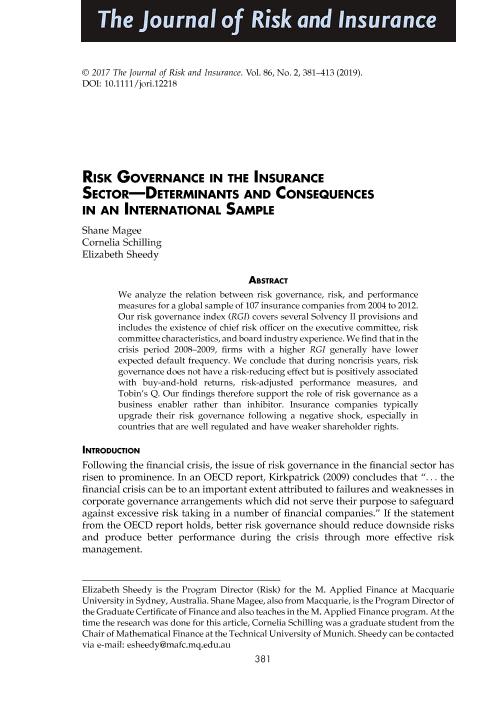Risk governance in the insurance sector -determinants and consequences in an international sample

Contenido multimedia no disponible por derechos de autor o por acceso restringido. Contacte con la institución para más información.
| Tag | 1 | 2 | Value |
|---|---|---|---|
| LDR | 00000cab a2200000 4500 | ||
| 001 | MAP20190019644 | ||
| 003 | MAP | ||
| 005 | 20190625125337.0 | ||
| 008 | 190624e20190603usa|||p |0|||b|eng d | ||
| 040 | $aMAP$bspa$dMAP | ||
| 084 | $a7 | ||
| 100 | 1 | $0MAPA20190008532$aMagee, Shane | |
| 245 | 0 | 0 | $aRisk governance in the insurance sector -determinants and consequences in an international sample$cShane Magee, Cornelia Schilling, Elizabeth Sheedy |
| 300 | $a33 p. | ||
| 520 | $aWe analyze the relation between risk governance, risk, and performance measures for a global sample of 107 insurance companies from 2004 to 2012. Our risk governance index (RGI) covers several Solvency II provisions and includes the existence of chief risk officer on the executive committee, risk committee characteristics, and board industry experience.Wefind that in the crisis period 20082009, firms with a higher RGI generally have lower expected default frequency. We conclude that during noncrisis years, risk governance does not have a risk-reducing effect but is positively associated with buy-and-hold returns, risk-adjusted performance measures, and Tobin's Q. Our findings therefore support the role of risk governance as a business enabler rather than inhibitor. Insurance companies typically upgrade their risk governance following a negative shock, especially in countries that are well regulated and have weaker shareholder rights. | ||
| 650 | 4 | $0MAPA20080591182$aGerencia de riesgos | |
| 650 | 4 | $0MAPA20080590567$aEmpresas de seguros | |
| 650 | 4 | $0MAPA20080564254$aSolvencia II | |
| 700 | 1 | $0MAPA20190008549$aSchilling, Cornelia | |
| 700 | $0MAPA20090035782$aSheedy, Elizabeth | ||
| 773 | 0 | $wMAP20077000727$tThe Journal of risk and insurance$dNueva York : The American Risk and Insurance Association, 1964-$x0022-4367$g03/06/2019 Volumen 86 Número 2 - junio 2019 , p. 381-413 |

